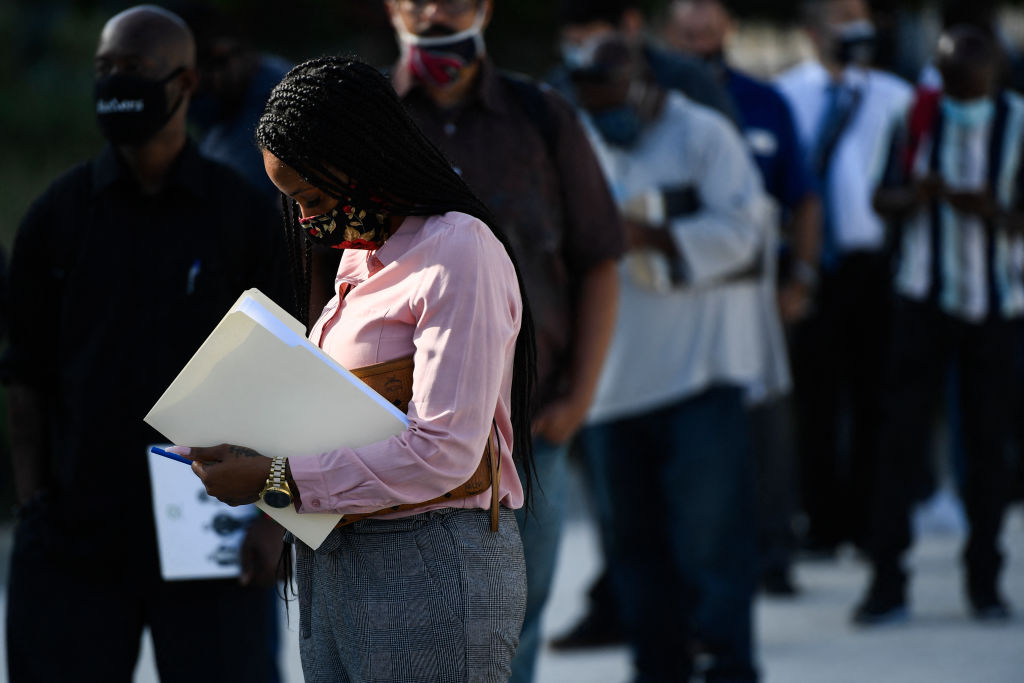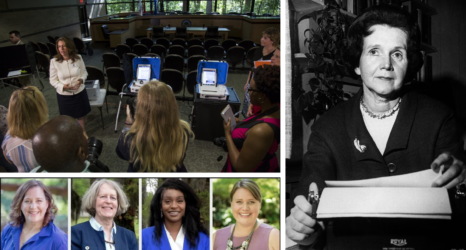Between February 2020 and now, about 1.1 million women are still missing from the labor force. The U.S. can and must do better by the majority of its citizens: women and kids.

Unemployment edged down, and job growth widespread—that was the headline paragraph from the latest U.S. Bureau of Labor Statistics (BLS) Employment Situation Survey. For the second month in a row, employment rose by a substantial chunk and unemployment decreased to 3.8 percent—down from 4 percent the previous month. The agency summarized the good news this way: “Growth was led by gains in leisure and hospitality, professional and business services, health care, and construction.”
Women workers have suffered the most in the COVID job market crash beginning in 2020, and the situation has been especially dire across the leisure and hospitality sector, where women—and many women of color—held more than 53 percent of the jobs. So this is great news for women, right?
Not so fast. Two paragraphs down, the BLS news turned from sunny to sour. While the unemployment rates for adult men declined in February, the jobless rates for adult women showed little or no change over the month.
This on top of the previous month’s report, which showed jobs dominated by women were on the forefront of losses—including work in the leisure and hospitality field where restaurants, bars, travel and tourism, lodging, and recreation that took big hits at the height of the pandemic. And while women comprise 52.7 percent of the workforce in that sector, the lion’s share of the jobs added in January (65 percent) and February (61 percent) went to men.
Even the “little or no change” in unemployment for women reported by the BLS didn’t actually apply to all women. While the statistic for the entire female population lumped together basically stayed even with the month before, Black women lost ground. Their unemployment rate increased from 5.8 percent in January to 6.1 percent in February, and nearly a third had been out of work six months or longer.
While women comprise 52.7 percent of the workforce in the leisure and hospitality sector, the lion’s share of the jobs added in January (65 percent) and February (61 percent) went to men.
Overall, as of the start of 2022, men have already recouped their pandemic job loss. By February 2022, there were about 500,000 more men in the workforce than there were in February 2020 before the pandemic. About 1.1 million women are still missing from the labor force.
Maybe the real headline should have been: The higher job growth goes, the more behind women get.
The latest numbers showing female job recovery virtually stalled underscore what we already knew. It’s been clear from the start of the pandemic in 2020 that women, most notably women of color, lost far more jobs than men.
Lack of childcare has been a primary reason.
When daycare and schools shut down, it’s a straight up economic calculation in a two-earner family for the lower earner (guess who?) to quit and take care of kids. In a single-parent household (again, predominately women of color) there’s no decision at all. Not only are daycare and school workers—overwhelmingly female—out of jobs, so are the women further up the ladder who depended on them in order to go to work.
Fortunately there is some good news for women in the labor market generally. Wages are ticking up, particularly in female-dominated low wage employment. This year, 26 U.S. states and Washington will raise their minimum wages, but only California and parts of New York will mandate hourly pay of at least $15.
The private sector is ahead of the government in raising wages that will primarily benefit women workers. Last year marked the first time that the average wage of Other employers have surpassed the $15 benchmark already. Amazon has paid its workforce at least $15 an hour since 2018, and began offering new hires an average of $18 an hour last September. Costco raised its minimum wage to $17 an hour in October. T-Mobile is paying its 75,000-person workforce at least $20 an hour. Bank of America has pledged to pay hourly workers $25 an hour by 2025, and Target made headlines in early March when it announced employees in some states would be hired at $24 an hour this year.
Economic Justice for Women and Long-Term Fixes
Higher wages are of course welcome news. But as the pandemic (hopefully) recedes in the rearview mirror and jobs come back, we need to look deeper and think longer term about fixes for women that won’t disappear when the next superbug comes along.
Here’s a partial list from the Center for American Progress in Washington, D.C.:
- Create a robust care infrastructure, including high quality affordable childcare and universal preschool, paid family and medical leave, and increased funding for long-term care services.
- Ensure fair and equal wages and quality benefits by eliminating the tipped minimum wage and raising the federal minimum to $15 per hour, banning the use of salary history in setting pay, and targeted hiring programs to reduce the occupational segregation that keeps too many women in traditional “women’s jobs” meaning lower pay and zero benefits.
- Strengthen and enforce protections against discrimination, harassment and retaliation which are especially important not only to women, but LGBTQ people, and those with disabilities.
- Expand employment protections for nontraditional workers, including part-time workers, independent contractors and temporary workers.
- Strengthen the progressive system of supports including permanent, expanded and refundable child care tax credit.
Our country can and must do better by the majority of our citizens—women and kids.
Until that happens, we will continue to fall behind the rest of the developed world—and, more importantly—miss a once-in-a-century opportunity to better the lives of all.
Up next:





